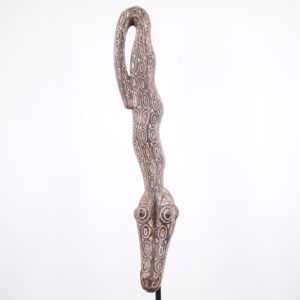“The various tribes living in Burkina Faso (formerly Upper-Volta), Ghana and Togo cultivate millet and cotton, and rear cattle in the northern savannah regions. Their religious activities are dictated by the rhythm of the seasons – during the dry season in particular, when the fields are fallow, large festivals and ceremonies are organized.
The 300,000 Bwa people are scattered across Mali and Burkina Faso. They are classified into three endogamous professional castes: farmers, blacksmiths and musicians.
The Bwa carve polychrome animal masks in horizontal shapes which symbolize butterflies or hawks. The butterfly mask is decorated with concentric circles, while the hawk mask has a plain white surface. Another mask called Nwantantay has a circular face with triangular decoration below the mouth and is surmounted by a large plank with a crescent-shaped motif at the end. It was worn during dances accompanying funerals and for entertainment festivities on market days.
Bwa figures are relatively rare and are associated with divination ceremonies and human and agricultural fertility rites. They are paraded through villages and are offered sacrifices.
Source:
Baquart, Jean-Baptiste. The Tribal Arts of Africa. New York: Thames and Hudson Inc. 1998. Print.


